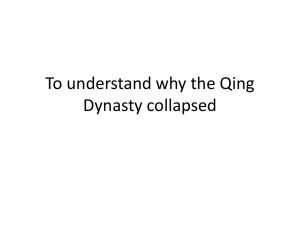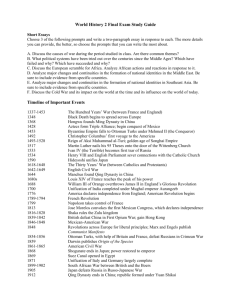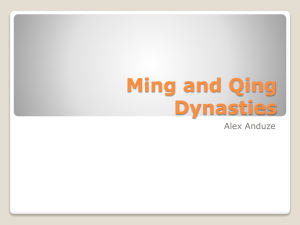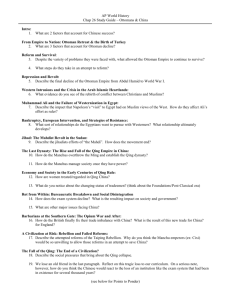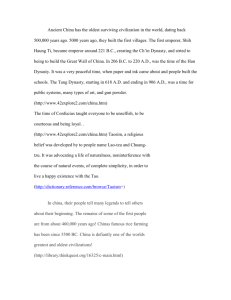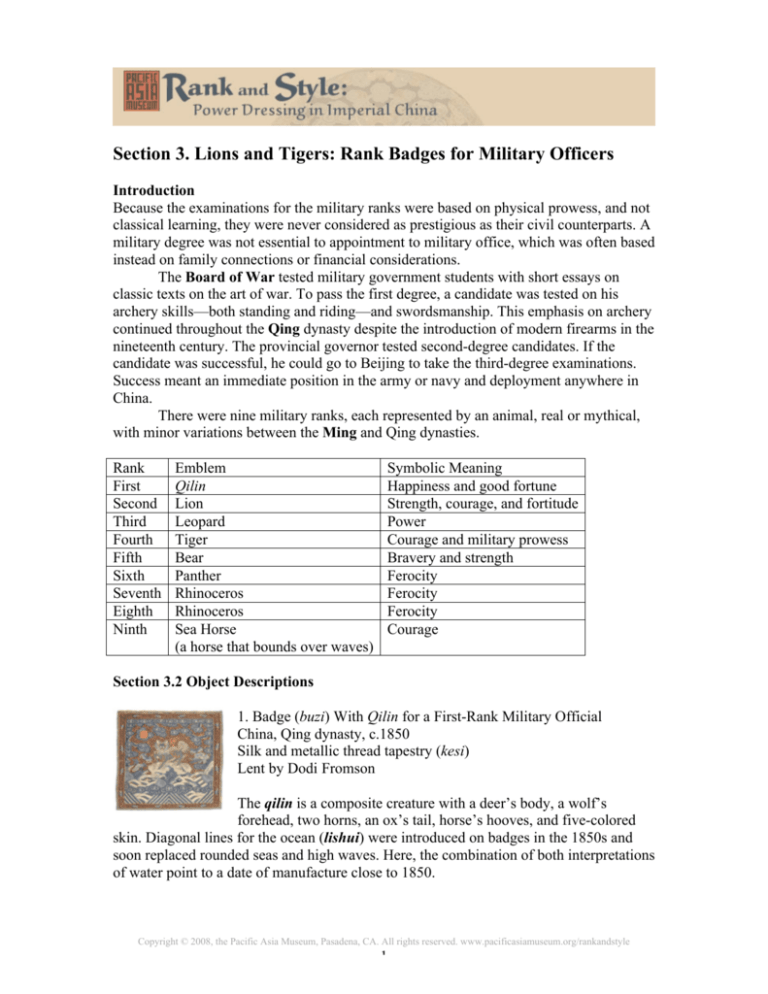
Section 3. Lions and Tigers: Rank Badges for Military Officers
Introduction
Because the examinations for the military ranks were based on physical prowess, and not
classical learning, they were never considered as prestigious as their civil counterparts. A
military degree was not essential to appointment to military office, which was often based
instead on family connections or financial considerations.
The Board of War tested military government students with short essays on
classic texts on the art of war. To pass the first degree, a candidate was tested on his
archery skills—both standing and riding—and swordsmanship. This emphasis on archery
continued throughout the Qing dynasty despite the introduction of modern firearms in the
nineteenth century. The provincial governor tested second-degree candidates. If the
candidate was successful, he could go to Beijing to take the third-degree examinations.
Success meant an immediate position in the army or navy and deployment anywhere in
China.
There were nine military ranks, each represented by an animal, real or mythical,
with minor variations between the Ming and Qing dynasties.
Rank
First
Second
Third
Fourth
Fifth
Sixth
Seventh
Eighth
Ninth
Emblem
Qilin
Lion
Leopard
Tiger
Bear
Panther
Rhinoceros
Rhinoceros
Sea Horse
(a horse that bounds over waves)
Symbolic Meaning
Happiness and good fortune
Strength, courage, and fortitude
Power
Courage and military prowess
Bravery and strength
Ferocity
Ferocity
Ferocity
Courage
Section 3.2 Object Descriptions
1. Badge (buzi) With Qilin for a First-Rank Military Official
China, Qing dynasty, c.1850
Silk and metallic thread tapestry (kesi)
Lent by Dodi Fromson
The qilin is a composite creature with a deer’s body, a wolf’s
forehead, two horns, an ox’s tail, horse’s hooves, and five-colored
skin. Diagonal lines for the ocean (lishui) were introduced on badges in the 1850s and
soon replaced rounded seas and high waves. Here, the combination of both interpretations
of water point to a date of manufacture close to 1850.
Copyright © 2008, the Pacific Asia Museum, Pasadena, CA. All rights reserved. www.pacificasiamuseum.org/rankandstyle
1
2. Badge (buzi) With Qilin for a First-Rank Military Officer
China, Qing dynasty, c. 1830
Silk and metallic thread tapestry (kesi), ink
Lent by the Ruth Chandler Williamson Gallery, Scripps College
The qilin is a good omen because it only appears during the reign of
a benevolent ruler. Other auspicious characteristics attributed to the
creature are longevity, grandeur, happiness, famous sons, and wise administration.
3. Badge (buzi) With Lion for a Second-Rank Military Officer
China, Qing dynasty, 1850-70
Silk and metallic thread, peacock feather filament embroidery
Pacific Asia Museum, Gift of Mr. and Mrs. Henry N. Foster,
1979.17.1
The lion symbolizes protection, harmony, blessings, and high rank.
4. Badge (buzi) With Lion for a Second-Rank Military Officer
China, Qing dynasty, c.1830
Silk and metallic thread tapestry (kesi), ink
Lent by the Ruth Chandler Williamson Gallery, Scripps College
Animals on military badges were always depicted with their mouths
open, perhaps to emphasize their ferocity. Lions were conventionally
shown with curled tails, manes, and back hair, which distinguish them from the
representations of bears.
5. Badge (buzi) With Leopard for a Third-Rank Military Officer
China, Qing dynasty, 1850-70
Silk and metallic thread tapestry (kesi), ink
Pacific Asia Museum, Museum Purchase, 1997.65.4
In the Ming dynasty, the leopard and tiger both designated the third
and fourth ranks. As a result of the first dress regulations of the new
Qing dynasty in 1662, the leopard was assigned permanently to the third rank and the
tiger to the fourth.
6. Badge (buzi) With Tiger for a Fourth-Rank Military Officer
China, early Qing dynasty, 1644-1652
Silk, metallic and peacock feather filament thread brocade
Lent by Chris Hall, Hong Kong
During the Ming dynasty, either the tiger or leopard represented the
fourth military rank. The Qing continued the Ming system from 1644 to 1652. Then from
1652 until 1664, the leopard was assigned the fourth rank and the tiger the third. From
1664 to the end of the dynasty the emblems were reversed: the leopard signifying the
third rank and the tiger established as the fourth-rank emblem.
Copyright © 2008, the Pacific Asia Museum, Pasadena, CA. All rights reserved. www.pacificasiamuseum.org/rankandstyle
2
7. Badge (buzi) With Tiger for a Fourth-Rank Military Officer
China, Qing dynasty, c.1850
Silk and metallic thread tapestry (kesi), ink
Lent by the Ruth Chandler Williamson Gallery, Scripps College
Two conventional marks frequently appear on representations of the
tiger in Chinese art: the character _ (“wang,” meaning “king”) on
its forehead (slightly distorted here) and a swirl of fur on its hind leg.
8. Badge (buzi) With Tiger for a Fourth-Rank Military Officer
China, Qing dynasty, 1850-70
Silk and metallic thread tapestry (kesi), ink
Pacific Asia Museum, Gift of Miss Mabel Kay, 1969.1.109
The tiger was believed to show courage and ferocity, two
characteristics valued in a military officer. In addition, the tiger was
considered a superior being able to protect against evil forces. As such it was often
depicted on dress and accessories for young children.
9. Badge (buzi) With Bear for a Fifth-Rank Military Officer
China, Ming dynasty, c.1500
Silk and metallic thread tapestry (kesi)
Lent by Chris Hall, Hong Kong
Throughout the Ming and Qing dynasties the bear remained the
emblem of the fifth-rank military officer, although its representation
was rather fanciful, more mythical than real. Here the bear looks backward, a Chinese
artistic convention begun in the Tang dynasty (618-906) that imparts a sense of
movement to the animal. Note that there is no sun, as this was not added to badges until
the seventeenth century.
10. Badge (buzi) With Bear for a Fifth-Rank Military Officer
China, Qing dynasty, 1840-50
Silk and metallic thread embroidery
Pacific Asia Museum, Gift of Mrs. Russell Dod, 1977.24.14
The bear stood for ferocity, strength and courage. Bears can be
distinguished from lions on rank badges by their straight tails and
manes—sometimes shown with tight curls near their bases.
Copyright © 2008, the Pacific Asia Museum, Pasadena, CA. All rights reserved. www.pacificasiamuseum.org/rankandstyle
3
11. Badge (buzi) With Panther for a Sixth-Rank Military Officer
China, Qing dynasty, 1820-50
Silk and metallic thread embroidery
Lent by Dodi Fromson
Until 1652 the panther was the emblem of the sixth and seventh
military ranks, but in the laws of 1652 the panther was given to the
sixth rank and the seventh rank shared the rhinoceros with the eighth rank. The canopy
over the panther is one of the Eight Buddhist Symbols that represent the Buddha’s
teachings and bring good fortune.
12. Seventh-Rank Military Official
China, Qing dynasty, 19th century
Original: ink and color on paper
Chris Hall Collection Trust, Hong Kong
Photo courtesy of Asian Civilisations Museum, National Heritage Board,
Singapore
The emblem for seventh- and eighth-rank military officials was the rhinoceros. Few of
these badges survive, probably because their owners destroyed them when the empire fell
in 1911. The convention for representing the rhinoceros, long extinct in China, was a
slender, cow-like animal, pale brown with large dark spots and flames shooting from
flanks and withers.
13. Ninth-Rank Military Official
China, Qing dynasty, 19th century
Original: ink and color on paper
Chris Hall Collection Trust, Hong Kong
Photo courtesy of Asian Civilisations Museum, National Heritage Board,
Singapore
Throughout the Ming and Qing dynasties the emblem for the ninth rank military official
was the sea horse, a mythical creature that looked like a white horse with flames
emanating from its withers and flanks, shown bounding over waves. Most of these lower
ranking badges were destroyed at the end of the Qing dynasty to avoid punishment for
their owners as soldiers of the emperor.
Copyright © 2008, the Pacific Asia Museum, Pasadena, CA. All rights reserved. www.pacificasiamuseum.org/rankandstyle
4



